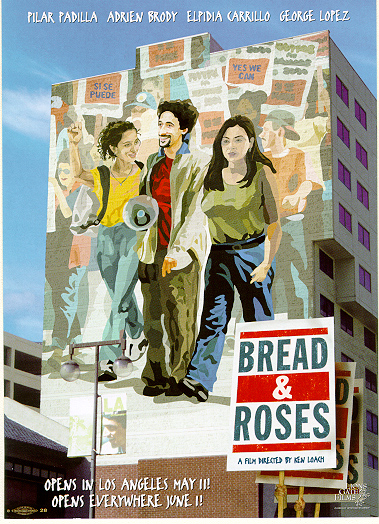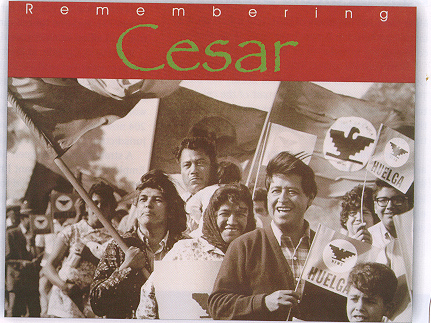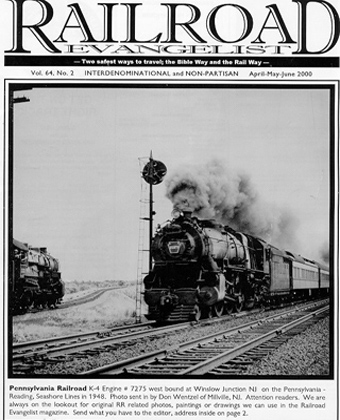| Bread & Roses

Bread and Roses is a new movie by Director Ken Loach about the
struggle of invisible office cleaners to gain dignity and respect at work.
Lions Gate Films released the movie May 11 in Los Angeles and it
opened throughout the United States on June 1 to coincide with SEIU’s
national fast for workplace justice and immigration reform on Justice
for Janitors Day, June 15, 2001.
The story is fictional, but it is based on the inspirational real-life
story of the Los Angeles janitors who beat the odds to win better lives
through SEIU’s Justice for Janitors campaign. The film received
outstanding reviews at Cannes 2000 and won best foreign film at the Rio de
Janeiro Film Festival.
This is a rare chance to see a great "working people’s"
film in your neighborhood theater. Many scenes will make you laugh. Many
will touch your heart. Overall, Bread and Roses will make you think
about the present day barriers that immigrant workers are still
confronting to gain a voice at work.
------------------
Bread and Roses, the song striking textile workers sang in the
early 1900s — "Hearts starve as well as bodies, give us bread
but give us roses" — also inspired the Bread & Roses
Cultural Project of Health & Human Service Employees Union 1199/SEIU.
The project runs music, art and poetry programs for union members in New
York City and its website www.bread-and-roses.com/shopping
index.html (800-666-1728) offers posters that include the work of
New York City high school students who participated in Bread and Roses
student exhibitions.
The site also features posters and books from the "Women of
Hope" series, with striking photos of social justice heroines from
around the world. Also still available is a 2001 calendar featuring the
art of Ralph Fasanella, whose colorful work depicts the joys and trials of
working people.
Ordinary People, Extraordinary Lives: 100 Years of Labor in New York
City
120 photographs that powerfully depict New York City’s working people
is on display at the George Meany Memorial Archives through June 24. Drawn
primarily from the work of labor photographers, the images show the men
and women who built New York City during the 20th century —
from sweatshop workers to construction crews building Wall Street.
Curators for the exhibit, Debra Bernhardt and Rachel Bernstein, recently
wrote a 240-page book that includes many of the photos, Ordinary
People, Extraordinary Lives: A Pictorial History of New York City’s
Working People, available at www.nyupress.nyu.edu/labor.
Bernhardt, 47, a noted labor archivist, died of cancer in March. For
directions and more information, call 301-431-5451.
Union Communication Services
Union Communication Services, Inc. has been a publisher of
communications and education tools for unions across North America since
1980 and is a 100% Union Shop. You can order by mail, UCS Books, 165
Conduit St., Annapolis, MD 21401-2512, by phone, 800-321-2545, by fax,
410-626-1353, or visit their website, www.unionist.com. A
few selections from their 2001 catalog:
A People’s History of the United States: 1492 — Present by
Howard Zinn (688 Pages, Paperback, $18)
BMWE members Paul Beard and Jed Dodd say this is a "must
read" for every working man and woman. "It’s size looked a
little intimidating," said Paul, "but it’s so easy to read you
don’t want to stop until you’re finished. It’s amazing how
informative it is."
This amazing account of America is seen through the eyes of its working
people, women and minorities. Zinn, a widely respected Boston University
professor, turns history on its head with his carefully researched and
dramatic recounting of America and its people — not just its bankers,
industrialists, generals and politicians.
Zinn looks at things differently. Your old school textbooks probably
described how Columbus discovered America. The way Zinn sees it, there was
a "European invasion of the Indian settlements in the Americas."
Where your old history teacher devoted a sentence or two, at best, to the
huge wave of industrial union organizing in the 1930s and 1940s, Zinn
devotes a chapter. And where your old history book made passing reference
to slavery and those who fought it, Zinn describes the real scope and
amazing struggle against that loathsome institution.
This book will give you a whole new way of looking at and understanding
the world around you.
STRIKE! By Jeremy Brecher (420 pages, Paperback, $22)
This book tells you something your school history books almost
certainly did not: how working Americans for the past 125 years have used
the strike again and again to win a degree of justice and fair play.
Beginning with the Great Upheaval of 1877 (the railroad strike), STRIKE!
tells of the nation’s great strikes and the social and political
climates from which they grew. Readers see the evolution of the strike:
from a class-wide struggle across industries to a time of collective
bargaining in which "workers think of their struggle in terms of
their own industry or workplace alone."
Brecher also examines the ever-shifting roles and configurations of
unions, from the Knights of Labor of the 1800s, formed in reaction to the
elitist trade unions of the day, to the AFL-CIO of the 1990s.
Ending with the 1997 Teamster strike against UPS, STRIKE!
illustrates that, throughout recent history, no matter how all
encompassing or industry-specific the strike, "the real issue is an
attempt by workers to wrest at least a part of the power over their lives
away from their employers and exercise it themselves."
Ravenswood: The Steelworkers’ Victory and the Revival of American
Labor by Tom Juravich and Kate Bronfenbrenner (245 Pages, Paperback,
$15.95)
BMWE member Perry Rapier who has had the "great good fortune of
studying under Prof. Bronfenbrenner" of Cornell University, says
Juravich’s and Bronfenbrenner’s book "puts you right there; the
descriptive writing makes you feel as if you were on the picket line with
the workers, feeling their pain and anguish."
This is the dramatic story of a big win for labor: the victory over
Ravenswood Aluminum Co. by 1,700 Steelworkers, who won their jobs back
after a 20-month lockout in the early 1990s. Unions had been suffering
defeat after defeat at the hands of corporate sharks and anti-union
politicians in the years leading up to this fight — PATCO, Eastern
Airlines and International Paper were just three of the nightmares that
flattened the labor movement — and the Steelworkers were determined to
draw the line. Using creative tactics that spanned the continent and even
the Atlantic ocean, and blessed by a membership that just wouldn’t give
up (only 17 members crossed the picket line) the members of USWA Local
5668 won, and won big. Making the story even more interesting, and in fact
helping their cause, was the fact that the company was owned by a
world-renowned financier, fugitive from justice and white-collar criminal
hiding out in Switzerland.
(Marc Rich, pardoned by President Clinton in January, "was the
mystery-man-in-exile who controlled the Ravenswood Aluminum Company in
Ravenswood, West Virginia. In the middle of the night back in October
1991, Rich’s private army of goons physically ejected hundreds of
Steelworkers from their jobs and declared all 1,700 USWA Local 5668
members locked out. Rich’s underlings turned the plant into an armed
bunker. Barbed-wire fences, boarded-up windows, an armored train full of
hundreds of scabs, stormtroopers with attack dogs, and everything in sight
illuminated with searchlights and covered with bullet-proof steel casing.
Workers called it Fort RAC."---Chris Townsend of UE in the Labor
Party Press, April 2001.)
The unionists’ victory at Ravenswood was a much-needed boost for all
of labor and lessons learned during the battle, detailed in these pages,
have become an integral part of the union arsenal.
Downsize This! Random Threats from an Unarmed American by Michael
Moore (317 Pages, Paperback, $12)
BMWE member Tom McCoy, who was given the book not too long ago by Paul
Beard, says Moore’s New York Times bestseller "made him
laugh out loud."
With the same biting humor and insight he brought to his movie Roger
and Me and television show, T.V. Nation, Michael Moore uses his
off-beat investigative and reporting styles to explore the downsizing of
the United States and the business and political reasons behind it.
For example, Moore wonders how far some politicians will go for money.
He sends campaign contribution checks from bogus organizations like
"Satan Worshippers for Dole" to Pat Buchanan, Ross Perot and Bob
Dole, to see who’s greedy enough to cash them. Another chapter provides
"Corporate Crook Trading Cards" for some of the most notorious
CEOs. Learn their favorite leisure activities, their annual pay and how
many jobs were trashed under the reign of guys like Nike’s Philip
Knight.
Moore considers all the possible causes, from union leadership to Pat
Buchanan and President Clinton, in getting you to understand the country’s
far-reaching and dangerous economic problems. He also offers suggestions
on 10 ways to downsize your boss.
The Legacy of Cesar Chavez

Remembering Cesar: The Legacy of Cesar Chavez, compiled by Ann
McGregor and edited by Cindy Wathen, with photographs by George Elfie
Ballis, is a personal and moving tribute to the late Cesar Chavez, founder
and president of the United Farm Workers. The firsthand accounts from 47
friends, interwoven with black and white photographs, portray a humble,
principled man of vision, driven by a passion to improve the lives of farm
workers. The first book to receive the endorsement of the Cesar E. Chavez
Foundation, the book’s contributors include Coretta Scott King, Martin
Sheen, Henry Cisneros, Jerry Brown, Edward James Olmos, UFW staff, the
Chavez family, and farm workers themselves. Copies are $25 each and can be
ordered from the publisher, Quill Driver Books, by calling 1-800-497-4909.
Labor Heritage Foundation
The Labor Heritage Foundation, which encourages singing, dancing and
general merriment in union-building campaigns, offers a well-chosen
selection of union-oriented videos and music. Recordings include "Si
Se Puede," a 1976 recording of United Farm Worker classics with
arrangements and instrumentation by Los Lobos, in Spanish with printed
translation. There’s also "Where Have All the Flowers Gone: The
Songs of Pete Seeger," with 39 tunes performed by Bruce Springsteen,
Ani DiFranco, Bonnie Raitt and others.
Videos range from Norma Rae to such classics as The Salt of
the Earth and How Green Was My Valley to historical dramas,
including Matewan, John Sayles’ film about the struggles of coal
miners in post-World War I West Virginia, to the comic, such as 9 to 5,
starring Jane Fonda, Lily Tomlin and Dolly Parton, who kidnap their sexist
boss and take over the department.
You can find these items and many more in the Foundation’s catalog
featuring, books, videos, CDs, posters, notecards, buttons and T-shirts
with a labor theme. For copies of the catalog call the Labor Heritage
Foundation at 202-842-7879 or send an e-mail to laborheritage@erols.com.
You can also order items online by going to www.laborheritage.org.
Labor’s Troubadour, the autobiography of union balladeer Joe
Glazer, details the life of a union musician who has lifted the spirits of
workers for more than a half-century, singing on picket lines, in union
halls and at conventions. Glazer worked for the Textile Workers Union of
America and United Rubber Workers and helped found the Labor Heritage
Foundation, which seeks to strengthen the union movement through music and
the arts. Troubadour includes the lyrics to 70 union songs.
Available at bookstores or through Collector Records ($25, plus $3 for
shipping and handling.) To order, send a check made out to Collector
Records, 9225 Wendell St., Silver Spring, MD 20901-3533. For more
information, e-mail collectorrecord@hotmail.com.
Powell’s Books
Powell’s City of Books takes up an entire city block and holds a
computerized inventory of over a million titles — the largest used and
new book selection under one roof in the world. Workers at the mammoth
independent bookseller in Portland, Oregon became members of Longshore and
Warehouse Union Local 5 last year. If you are unable to travel to Portland
to visit the enormous store, you can order online at www.powells.com,
by phone toll-free at 866-201-7601 or mail at Powell’s City of Books,
1005 West Burnside, Portland, Oregon 97209.
In addition to many other books the AFL-CIO recommended for gift giving
last December were the following working family-friendly novels, equally
good for summer leisure reading:
Dreamland, by Kevin Baker, involves a gangster who falls in love
with a seamstress and union agitator on the Lower East Side in the era of
the Triangle Shirtwaist Factory fire. $6.99. HarperCollins.
Payback, by Thomas Kelly, is a thriller set amid the construction
boom in New York City in the 1980s. $6.99. Fawcett Crest.
Thunder on the Mountain, by David Poyer, centers around an accident
at a Pennsylvania oil company in 1936 that ultimately involves the
workers, the Congress of Industrial Organizations, Pinkertons and Eleanor
Roosevelt. $6.99. St. Martins.
Death & Blintzes, by Dorothy Rosen and Sidney Rosen, showcases
Belle Appleman, a garment worker and union member who helps the Boston
police track down the murderer of a fellow worker in 1936. $10.95. Academy
Chicago Publishers.
The Unquiet Earth, by Denise Giardina, is a tale of love, union
organizing and politics that takes place in an Appalachian mining town
during the Depression. $6.99. Ivy Books.
God’s Bits of Wood, by Sembene Ousmane, translated by Francis
Price, takes place during a 1947 railroad workers’ strike in
French-controlled Niger. $6.95. Heinemann.
For Young Union Readers:
Pat the Bunny, the tale of a lovable fuzzy rabbit, is published by
Golden Books, a company where workers have a voice on the job with UAW
Local 1007. $6.99. Ages newborn-3. Golden Books (www.goldenbooks.com)
also offers dozens of other titles children will enjoy.
Clack Clack Moo: Cows That Type, by Doreen Cronin, features bovine
justice-seekers who type up their demands for extra blankets to ward off
the cold night air. When Farmer Brown refuses, the cows go on strike. $15.
Ages 3-7. Simon and Shuster.
This book is also available from Union Communication Services and their
catalog description reads as follows: A delightful children’s book with
a union message! It seems that Farmer Brown has a problem. All day long he
hears click, clack, moo ... click, clack, moo, coming from the cow barn.
What’s all this about? He gets the answer when the cows send a note to
the farmhouse. They’re cold, they say. No milk, they say, until they get
electric blankets.
No way, says Farmer Brown. But then the hens join in, and before you
know it the ducks are acting as mediators. Then the ducks start getting
their own ideas ... but we don’t want to spoil it for you. Let’s just
say that Farmer Brown gets a lesson in labor-management relations and
union (or is that moonion?) Solidarity, in a way your kids (you,
too!) will get a real kick out of. Beautifully illustrated.
Riot, by Mary Casanova, follows the life of Bryan, a sixth-grader
who is caught in a web of conflicting family loyalties when his father
goes on strike. Ages 9-12. $4.95. Hyperion Paperbacks.
A. Philip Randolph: Labor Leader, by Sally Hanley, looks at the
life of the legendary African American leader of the Brotherhood of
Sleeping Car Porters. Ages 9-12. $9.95. Chelsea House Publishers.
Dolores Huerta, by Frank Huerta Perez, profiles the co-founder of
the United Farm Workers as part of the Contemporary Hispanic Americans
series. Ages 9-12. $4. Raintree Steck-Vaughn.
Lyddie, by Katherine Patterson, a coming-of-age story, explores the
life of a farm girl from Vermont who workers at a Lowell textile factory
in the 1840s. Young adults. $5.99. Puffin.
Big Annie of Calumet: A True Story of the Industrial Revolution,
by Jerry Stanley, profiles Annie Clemenc, who led protesters and inspired
workers when miners struck against the Calumet and Hecla Mining Company in
1913 in Michigan. Young adults. $19. Crown Publishers.
Rosie the Riveter: Women Working on the Home Front in World War II,
by Penny Colman, explores the lives of the millions of women who were
recruited to work at nontraditional jobs in defense plants, factories and
offices. All ages. $8.95. Crown Publishers.
Kids on Strike!, by Susan Campbell Bartoletti, tells the stories of
children who organized to improve their own working conditions in the
early 1900s. All ages. $20. Houghton Mifflin.
Labyrinth Books
Readers seeking a unionized bookstore now can order directly from
Labyrinth Books, www.labyrinthbooks.com, where UNITE Local 169 in
New York City recently organized 26 workers at the bookseller’s stores
and warehouses. Its website, which lists new releases by topic, enables
users to place special orders and search for any of the 125,000 titles the
company offers. Instructors can provide course textbook lists online and
the company makes the books available for students. Labyrinth joins Powell’s
books as a union-friendly Internet shopping option.
Magazines Make Great Gifts
Magazines are gifts that keep on giving throughout the year.
Get on the Right Track — Subscribe to the Railroad Evangelist,
7045 Koldyke Place, Fishers, Indiana 46038-2735. Quarterly. One-year
subscription: $8.

WorkingUSA: The Journal of Labor and Society, 800-541-6563 or www.mesharpe.com.
Quarterly. One-year subscription: $35.
Dollars and Sense, a bimonthly magazine of economic issues and
opinions from a worker-oriented point of view, 800-783-4903 or www.dollarsandsense.org.
One-year introductory subscription: $18.95.
Labor’s Heritage, a richly illustrated quarterly magazine that
celebrates the history of workers’ struggles for respect and dignity on
the job, 301-431-5457 or www.georgemeany.org. One-year
subscription: $19.95.
The Nation, 800-333-8536 or www.TheNation.com. 47 issues a
year. One-year subscription: $36.
Mother Jones, 800-438-6656 or www.motherjones.com. 6 issues
a year. One-year introductory subscription: $10.
America@work, 800-442-5645, in Washington, DC, 202-637-5044 or www.aflcio.org.
11 issues a year. One-year subscription: $10. |

